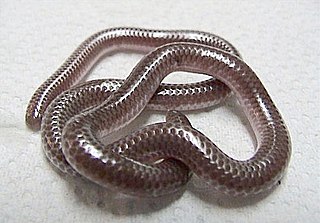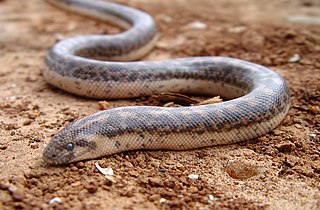
The Leptotyphlopidae are a family of snakes found in North America, South America, Africa, & Asia. All are fossorial and adapted to burrowing, feeding on ants and termites. Two subfamilies are recognized.

Rena humilis, known commonly as the western blind snake, the western slender blind snake, or the western threadsnake, is a species of snake in the family Leptotyphlopidae. The species is endemic to the southwestern United States and northern Mexico. Six subspecies are currently recognized, including the nominate subspecies described here.

Rena dulcis, also known commonly as the Texas blind snake, the Texas slender blind snake, or the Texas threadsnake, is a species of snake in the family Leptotyphlopidae. The species is endemic to the Southwestern United States and adjacent northern Mexico. Three subspecies are currently recognized, including the nominate subspecies described here.
Myriopholis blanfordi, the Sindh thread snake, is a species of harmless blind snake in the family Leptotyphlopidae. The species is endemic to India and the Middle East.

Eryx is a genus of nonvenomous boas known as Old World sand boas. They are found in southeastern Europe, northern Africa, the Middle East, and southwestern Asia. Nine species are currently recognized.

Leptotyphlops is a genus of nonvenomous blind snakes, commonly known as slender blind snakes and threadsnakes, in the family Leptotyphlopidae. The genus is endemic to and found throughout Africa. 11 species have been moved to the genus Trilepida, and other species have been moved to the genera Epacrophis, Epictia, Mitophis, Myriopholis, Namibiana, Rena, Siagonodon, Tetracheilostoma, and Tricheilostoma.
Echis ocellatus, known by the common names West African carpet viper and ocellated carpet viper, is a venomous species of viper endemic to West Africa. No subspecies are currently recognized.
The white-bellied worm snake is a species of snake in the family Leptotyphlopidae.
Tricheilostoma broadleyi is a species of snake in the family Leptotyphlopidae. The species is endemic to Ivory Coast.
Myriopholis burii, commonly known as the Arabian blind snake or Bury's worm snake, is a species of snake in the family Leptotyphlopidae. The species is endemic to the Arabian Peninsula.
The Cairo blind snake is a species of nonvenomous snake in the family Leptotyphlopidae. The species is endemic to Africa.
The Cape thread snake is a species of snake in the family Leptotyphlopidae. It has previously been considered a subspecies of Peter's thread snake, Leptotyphlops scutifrons. It was first described in 1861 as Stenostoma conjunctum.
Emin Pasha's worm snake is a species of snake in the family Leptotyphlopidae. The species is endemic to northern East Africa.

The Socotra Island blind snake is a species of snake in the family Leptotyphlopidae.
Nurse's blind snake is a species of snake in the family Leptotyphlopidae.
Namibiana occidentalis, also known as the western threadsnake or western worm snake, is a species of snakes in the family Leptotyphlopidae. It is found in Namibia and northwestern South Africa.
Myriopholis perreti is a species of snake in the family Leptotyphlopidae. The species is endemic to western Central Africa.
Wilson's blind snake is a species of snake in the family Leptotyphlopidae.
Van Stanley Bartholomew Wallach is an American herpetologist and an expert on blindsnakes and on the systematics, internal anatomy, and taxonomy of snakes. He has contributed to the descriptions of at least 46 species of snakes and has conducted fieldwork on tropical snakes in the Philippines, Nicaragua, and the Democratic Republic of the Congo.
Myriopholis is a genus of snakes in the family Leptotyphlopidae. Most of the species were previously placed in the genus Leptotyphlops.






